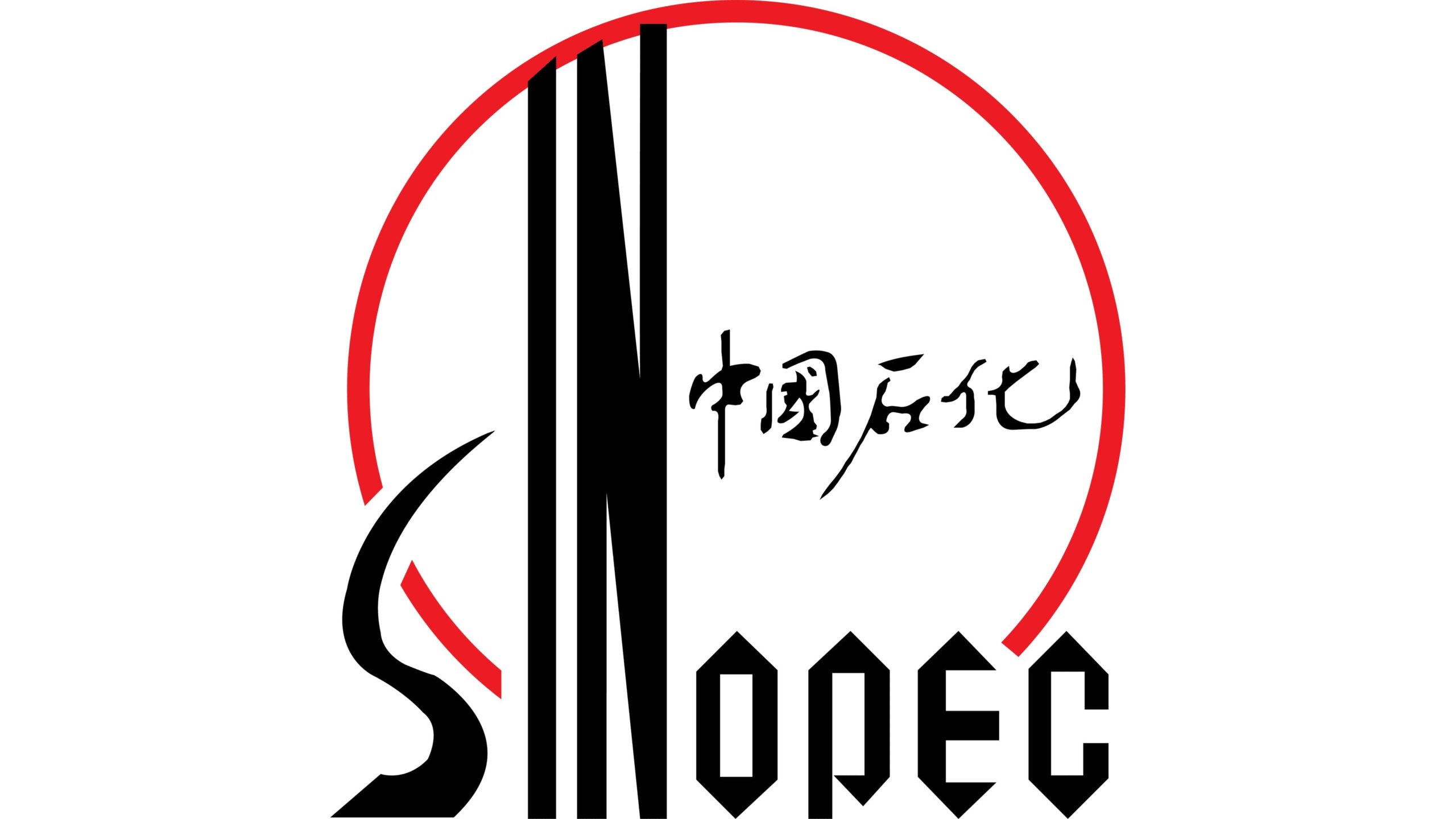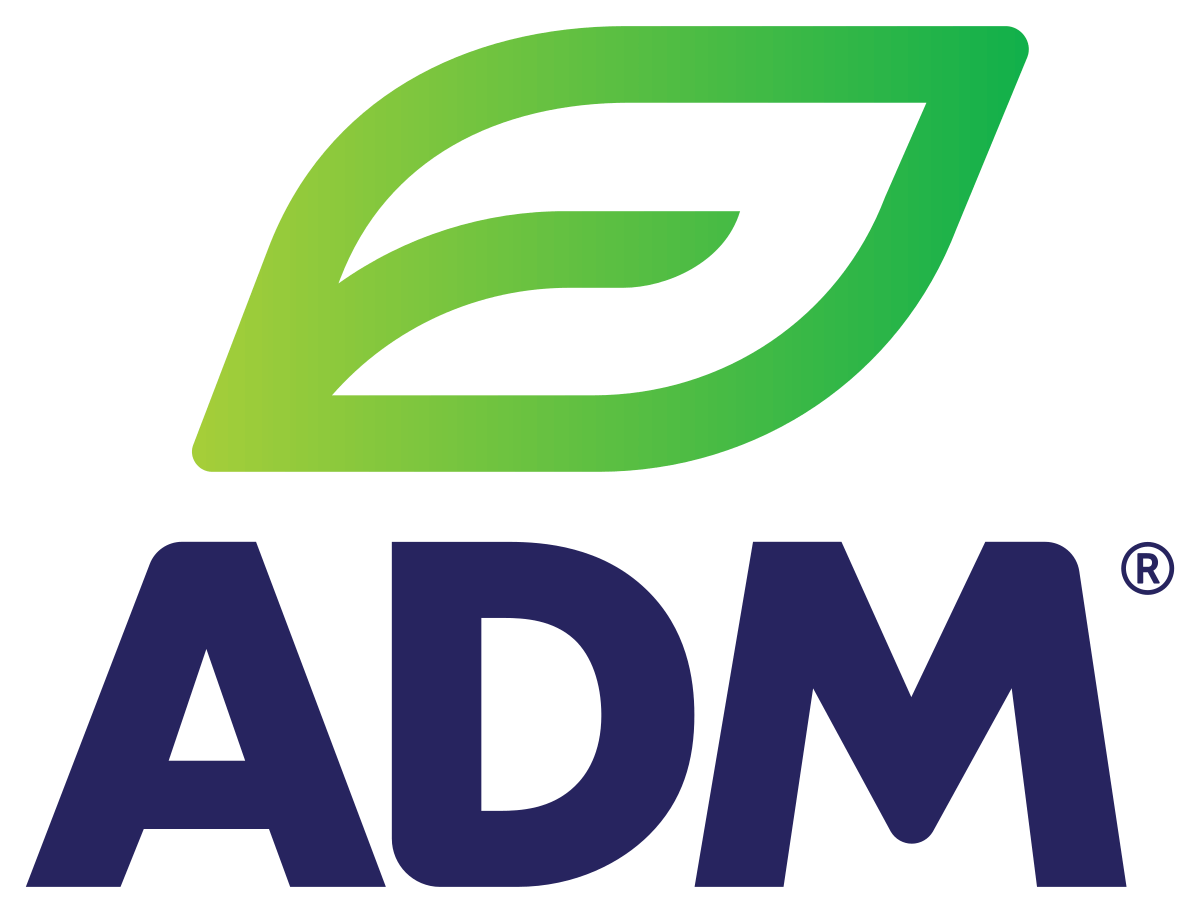Global Industrial Enzyme Market, By Source, By Enzyme Type, By Application, By Region & Segmental Insights Trends and Forecast, 2024 – 2034
- Industry: Chemicals & Materials
- Report ID: TNR-110-1317
- Number of Pages: 420
- Table/Charts : Yes
- September, 2024
- Base Year : 2024
- No. of Companies : 10+
- No. of Countries : 29
- Views : 10180
- Covid Impact Covered: Yes
- War Impact Covered: Yes
- Formats : PDF, Excel, PPT
Industrial enzymes are biocatalysts used in various sectors to enhance efficiency and sustainability in production processes. They play a crucial role in industries like food & beverages, where enzymes like amylases are used for bread-making and brewing. In detergents, proteases help break down stains, offering effective cleaning solutions. The biofuel industry utilizes cellulases to convert biomass into ethanol, promoting renewable energy. “In Terms of Revenue, the Global Industrial Enzyme Market was Worth US$ 7.8 Bn in 2023, Anticipated to Witness CAGR of 5.9% During 2024 – 2034.”
Enzymes are vital in day-to-day life due to their natural origin, biodegradability, and non-toxic properties. They are safe for the environment as they replace harsh chemicals, reducing pollution. For example, in 2022, industrial enzymes in waste treatment helped degrade organic materials, minimizing environmental hazards. Similarly, enzyme-based textiles enhance fabric quality with minimal water and chemical use, as seen in the 2021 sustainable textile initiatives.
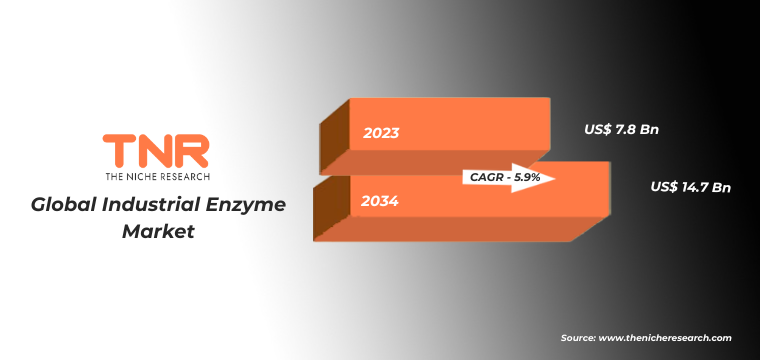
Microorganisms Used in Industrial Enzymes and Their Applications:
| Microorganism | Enzyme Type | Industrial Application | Example | Process of Enzyme Production |
| Aspergillus niger | Amylases, Proteases, Pectinases | Food & Beverages (e.g., brewing, baking), Textiles, Pulp & Paper | In 2022, Novozymes used Aspergillus niger to produce amylases for efficient starch hydrolysis in brewing. | Fermentation of the fungus in bioreactors, followed by extraction and purification of the enzymes. |
| Bacillus subtilis | Proteases, Lipases | Detergents, Pharmaceuticals, Textiles | In 2021, Unilever used Bacillus subtilis-derived proteases for enzyme-based detergents to improve stain removal. | Bacterial fermentation is performed in controlled conditions; the enzyme is then isolated and purified for industrial use. |
| Trichoderma reesei | Cellulases | Biofuels, Textile Processing, Pulp & Paper | In 2023, DSM used Trichoderma reesei cellulases to break down plant fibers for biofuel production. | The fungus is cultivated under aerobic conditions, and cellulases are extracted through downstream processing. |
| Escherichia coli | Recombinant Enzymes | Pharmaceuticals, Biotechnology | In 2022, Pfizer utilized E. coli for producing recombinant enzymes for drug manufacturing. | E. coli is genetically engineered to produce desired enzymes, which are then harvested and purified. |
| Saccharomyces cerevisiae | Invertases | Food & Beverages (e.g., sweeteners, fermentation), Biofuels | In 2021, DSM used Saccharomyces cerevisiae to produce invertases for sugar conversion in baking and brewing. | Yeast fermentation produces the enzyme, which is extracted through cell lysis and filtration processes. |
| Lactobacillus species | Lactic Acid Enzymes | Food Processing (e.g., dairy, yogurt production), Probiotics | In 2023, Chr. Hansen used Lactobacillus for yogurt fermentation, improving texture and shelf life. | Cultivation of bacteria in fermenters, followed by enzyme recovery through centrifugation and purification. |
| Penicillium species | Pectinases, Lipases | Fruit Juice Processing, Cosmetics, Detergents | In 2022, L’Oréal applied Penicillium-derived lipases in cosmetics for enhanced ingredient penetration. | Cultured in liquid media, and enzymes are harvested through filtration and concentration techniques. |
| Streptomyces species | Proteases, Amylases | Pharmaceuticals, Textiles, Pulp & Paper | In 2023, BASF used Streptomyces proteases for eco-friendly textile processing, reducing water use. | Grown in controlled fermentation tanks, enzymes are extracted and purified for industrial applications. |
Growth Drivers in the Global Industrial Enzyme Market:
Rising Demand for Sustainable Solutions: The global shift towards eco-friendly processes is a significant driver for the industrial enzyme market. In 2022, companies like Novozymes developed enzymes for detergents, reducing chemical use and water consumption, thus offering sustainable cleaning solutions. This trend promotes enzyme adoption in various sectors like textiles and biofuels.
Growth in Processed Food Industry: The increasing demand for processed and convenient foods fuels enzyme applications in food production. For instance, in 2021, DSM enhanced its enzyme solutions for baking, improving texture and shelf life without additives. Such innovations meet consumer demands for high-quality, clean-label food products, driving market growth globally.
Restraints in the Global Industrial Enzyme Market:
High Production Costs: The complex processes involved in enzyme production, including fermentation and purification, result in high costs. For instance, in 2022, enzyme manufacturers like BASF faced challenges with raw material and energy expenses, making it difficult for smaller businesses to adopt enzyme-based solutions, hindering market growth.
Regulatory Challenges: Strict regulations regarding enzyme usage, especially in food and pharmaceuticals, can limit market expansion. In 2021, delays in approvals from the FDA for novel enzyme-based additives impacted product launches. These regulatory hurdles create uncertainty for companies, slowing down innovation and commercialization efforts across industries like food and biofuels.
Global Industrial Enzyme Market Segmental Analysis:
Microorganisms have emerged as the dominant source in the global industrial enzyme market, accounting for 49.5% of revenue share. Bacteria and fungi, known for their efficiency and easy cultivation, are widely used. For example, in 2023, Novozymes leveraged Aspergillus niger, a fungus, to produce enzymes for the food and beverage industry, enhancing flavor and shelf life. Similarly, DSM utilized bacterial enzymes for biofuel production, increasing efficiency in 2022. Microorganisms offer sustainability, as they are renewable and produce high enzyme yields. Their adaptability to different industries, from detergents to pharmaceuticals, further solidifies their dominance in enzyme manufacturing globally.
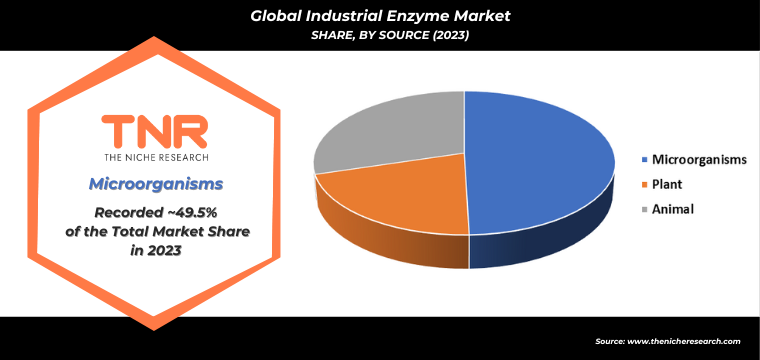
In 2023, the proteases segment secured its position as the second-largest enzyme type category in the global industrial enzyme market, with a revenue share of 23.5%. Proteases are widely used in detergents, helping break down protein stains like blood and food. For instance, Unilever used protease-enhanced detergents in 2022, improving stain removal while reducing water usage. Proteases also play a significant role in the food industry, such as in meat tenderization and cheese production, as seen with Chr. Hansen’s enzyme solutions in 2021. Their broad applications in sectors like pharmaceuticals, textiles, and animal feed fuel this market growth.
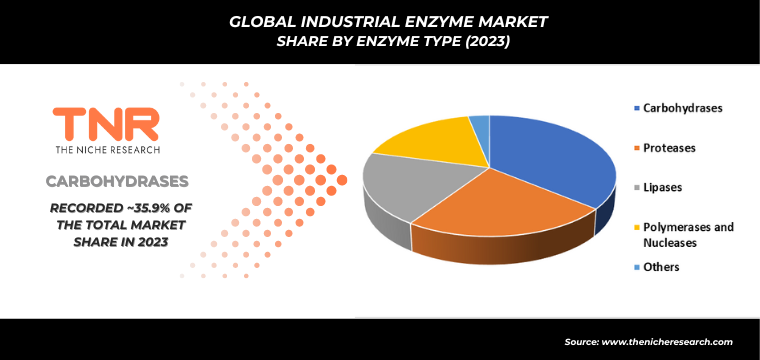
Cosmetics and personal care segment is projected to be the fastest-growing application category in the global industrial enzyme market, expected to hold a substantial 12.8% revenue share. In 2022, enzymes like lipases and proteases were increasingly utilized in skincare formulations to promote gentle exfoliation and improve product efficacy. For example, L’Oréal integrated enzyme-based ingredients in its anti-aging creams to enhance skin texture and cell renewal. Similarly, 2023 saw brands using enzymes for eco-friendly, biodegradable personal care products, aligning with consumer demand for natural, sustainable solutions. These innovations are driving the rapid expansion of enzymes in the cosmetics sector.
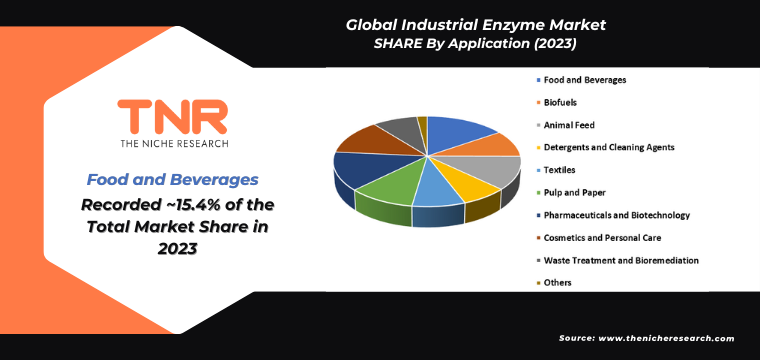
In 2023, Europe reinforced its third leading position in the global industrial enzyme market, capturing a significant revenue share of 24.7%. The region’s robust presence in the food & beverage, detergent, and biofuel industries has driven enzyme demand. For instance, Novozymes partnered with European biofuel producers in 2022 to use cellulases for efficient biomass conversion. Similarly, the rise in eco-friendly cleaning products boosted enzyme use in detergents, as seen with Unilever’s enzyme-based formulations. European consumers’ preference for sustainable and natural products further fuels enzyme applications across industries like cosmetics, promoting innovation and expansion in the regional enzyme market.
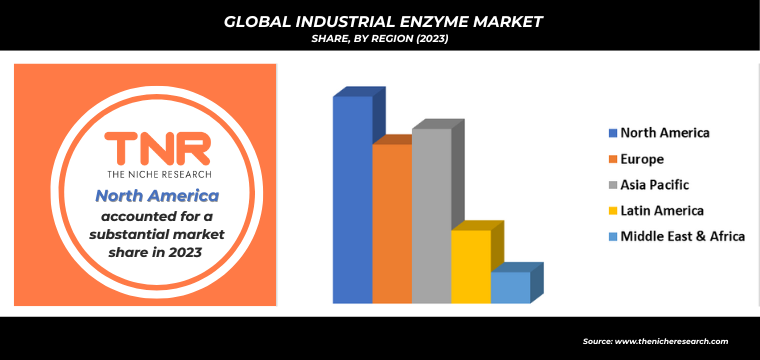
Competitive Landscape
Some of the players operating in the industrial enzyme market are
- Adisseo
- Advanced Enzyme Technologies
- Associated British Foods Plc
- BASF SE
- BioProcess Algae, LLC
- Hansen Holding A/S
- DSM
- DuPont Danisco
- Koninklijke DSM N.V.
- Lesaffre
- Novozymes
- NOVUS INTERNATIONAL
- Other Industry Participants
Global Industrial Enzyme Market Scope:
| Report Specifications | Details |
| Market Revenue in 2023 | US$ 7.8 Bn |
| Market Size Forecast by 2034 | US$ 14.7 Bn |
| Growth Rate (CAGR) | 5.9% |
| Historic Data | 2016 – 2022 |
| Base Year for Estimation | 2023 |
| Forecast Period | 2024 – 2034 |
| Report Inclusions | Market Size & Estimates, Market Dynamics, Competitive Scenario, Trends, Growth Factors, Market Determinants, Key Investment Segmentation, Product/Service/Solutions Benchmarking |
| Segments Covered | By Source, By Enzyme Type, By Application, By Region |
| Regions Covered | North America, Europe, Asia Pacific, Middle East & Africa, Latin America |
| Countries Covered | U.S., Canada, Mexico, Rest of North America, France, The UK, Spain, Germany, Italy, Nordic Countries (Denmark, Finland, Iceland, Sweden, Norway), Benelux Union (Belgium, The Netherlands, Luxembourg), Rest of Europe, China, Japan, India, New Zealand, Australia, South Korea, Southeast Asia (Indonesia, Thailand, Malaysia, Singapore, Rest of Southeast Asia), Rest of Asia Pacific, Saudi Arabia, UAE, Egypt, Kuwait, South Africa, Rest of Middle East & Africa, Brazil, Argentina, Rest of Latin America |
| Key Players | Adisseo, Advanced Enzyme Technologies, Associated British Foods Plc, BASF SE, BioProcess Algae, LLC, Chr. Hansen Holding A/S, DSM, DuPont Danisco, Koninklijke DSM N.V., Lesaffre, Novozymes, NOVUS INTERNATIONAL |
| Customization Scope | Customization allows for the inclusion/modification of content pertaining to geographical regions, countries, and specific market segments. |
| Pricing & Procurement Options | Explore purchase options tailored to your specific research requirements |
| Contact Details | Consult With Our Expert
Japan (Toll-Free): +81 663-386-8111 South Korea (Toll-Free): +82-808- 703-126 Saudi Arabia (Toll-Free): +966 800-850-1643 United Kingdom: +44 753-710-5080 United States: +1 302-232-5106 E-mail: askanexpert@thenicheresearch.com
|
Global Industrial Enzyme Market
By Source
- Microorganisms
- Bacterial Enzymes
- Fungal Enzymes
- Plant
- Animal
By Enzyme Type
- Carbohydrases
- Amylases
- Cellulases
- Xylanases
- Pectinases
- Proteases
- Alkaline Protease
- Acid Protease
- Lipases
- Polymerases and Nucleases
- Others
By Application
- Food and Beverages
- Biofuels
- Animal Feed
- Detergents and Cleaning Agents
- Textiles
- Pulp and Paper
- Pharmaceuticals and Biotechnology
- Cosmetics and Personal Care
- Waste Treatment and Bioremediation
- Others
By Region
- North America (U.S., Canada, Mexico, Rest of North America)
- Europe (France, The UK, Spain, Germany, Italy, Nordic Countries (Denmark, Finland, Iceland, Sweden, Norway), Benelux Union (Belgium, The Netherlands, Luxembourg), Rest of Europe)
- Asia Pacific (China, Japan, India, New Zealand, Australia, South Korea, Southeast Asia (Indonesia, Thailand, Malaysia, Singapore, Rest of Southeast Asia), Rest of Asia Pacific)
- Middle East & Africa (Saudi Arabia, UAE, Egypt, Kuwait, South Africa, Rest of Middle East & Africa)
- Latin America (Brazil, Argentina, Rest of Latin America)
Report Layout:
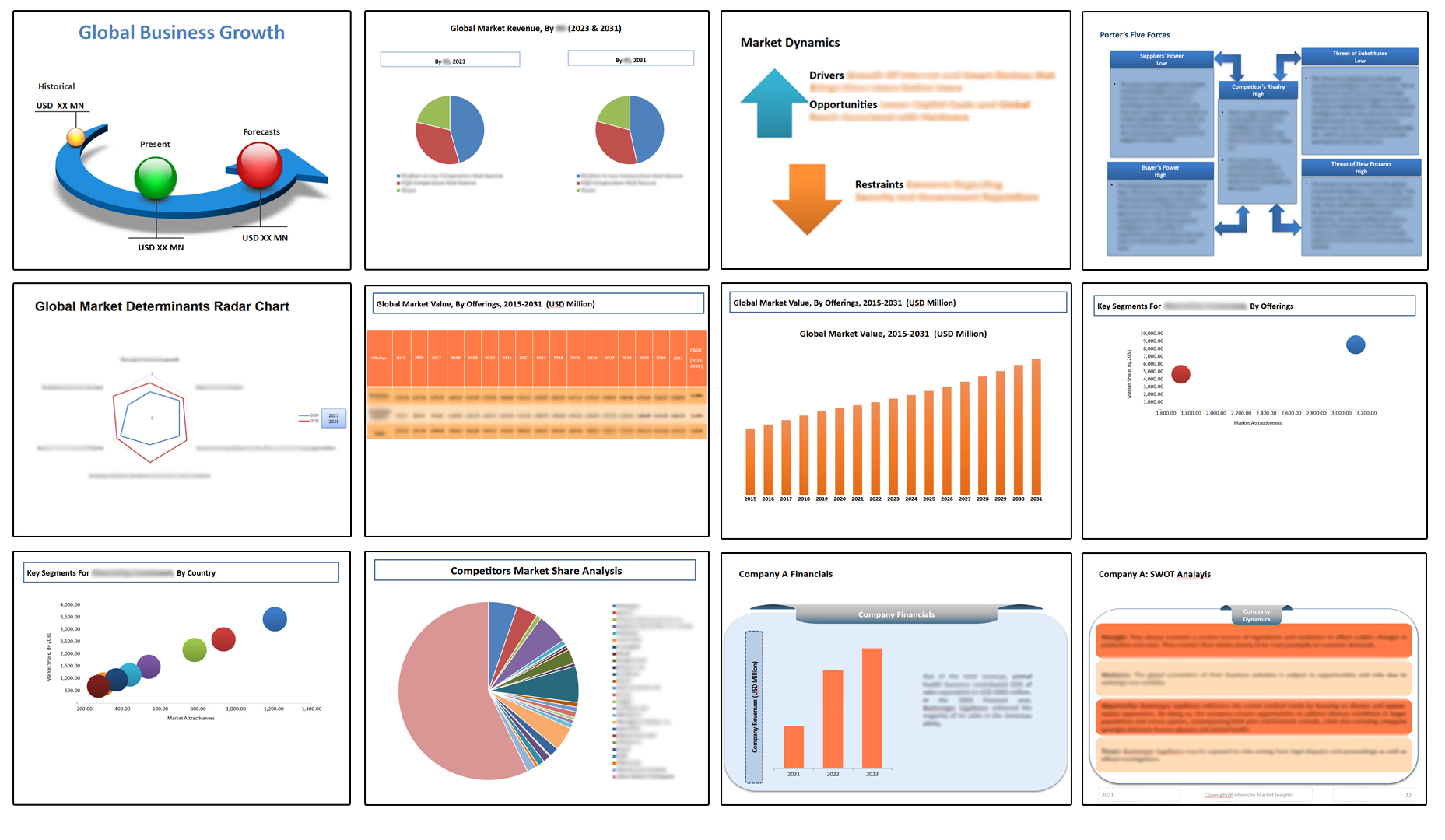
Table of Contents
Note: This ToC is tentative and can be changed according to the research study conducted during the course of report completion.
**Exclusive for Multi-User and Enterprise User.
Global Industrial Enzyme Market
By Source
- Microorganisms
- Bacterial Enzymes
- Fungal Enzymes
- Plant
- Animal
By Enzyme Type
- Carbohydrases
- Amylases
- Cellulases
- Xylanases
- Pectinases
- Proteases
- Alkaline Protease
- Acid Protease
- Lipases
- Polymerases and Nucleases
- Others
By Application
- Food and Beverages
- Biofuels
- Animal Feed
- Detergents and Cleaning Agents
- Textiles
- Pulp and Paper
- Pharmaceuticals and Biotechnology
- Cosmetics and Personal Care
- Waste Treatment and Bioremediation
- Others
By Region
- North America (U.S., Canada, Mexico, Rest of North America)
- Europe (France, The UK, Spain, Germany, Italy, Nordic Countries (Denmark, Finland, Iceland, Sweden, Norway), Benelux Union (Belgium, The Netherlands, Luxembourg), Rest of Europe)
- Asia Pacific (China, Japan, India, New Zealand, Australia, South Korea, Southeast Asia (Indonesia, Thailand, Malaysia, Singapore, Rest of Southeast Asia), Rest of Asia Pacific)
- Middle East & Africa (Saudi Arabia, UAE, Egypt, Kuwait, South Africa, Rest of Middle East & Africa)
- Latin America (Brazil, Argentina, Rest of Latin America)
The Niche Research approach encompasses both primary and secondary research methods to provide comprehensive insights. While primary research is the cornerstone of our studies, we also incorporate secondary research sources such as company annual reports, premium industry databases, press releases, industry journals, and white papers.
Within our primary research, we actively engage with various industry stakeholders, conducting paid interviews and surveys. Our meticulous analysis extends to every market participant in major countries, allowing us to thoroughly examine their portfolios, calculate market shares, and segment revenues.
Our data collection primarily focuses on individual countries within our research scope, enabling us to estimate regional market sizes. Typically, we employ a bottom-up approach, meticulously tracking trends in different countries. We analyze growth drivers, constraints, technological innovations, and opportunities for each country, ultimately arriving at regional figures.Our process begins by examining the growth prospects of each country. Building upon these insights, we project growth and trends for the entire region. Finally, we utilize our proprietary model to refine estimations and forecasts.
Our data validation standards are integral to ensuring the reliability and accuracy of our research findings. Here’s a breakdown of our data validation processes and the stakeholders we engage with during our primary research:
- Supply Side Analysis: We initiate a supply side analysis by directly contacting market participants, through telephonic interviews and questionnaires containing both open-ended and close-ended questions. We gather information on their portfolios, segment revenues, developments, and growth strategies.
- Demand Side Analysis: To gain insights into adoption trends and consumer preferences, we reach out to target customers and users (non-vendors). This information forms a vital part of the qualitative analysis section of our reports, covering market dynamics, adoption trends, consumer behavior, spending patterns, and other related aspects.
- Consultant Insights: We tap into the expertise of our partner consultants from around the world to obtain their unique viewpoints and perspectives. Their insights contribute to a well-rounded understanding of the markets under investigation.
- In-House Validation: To ensure data accuracy and reliability, we conduct cross-validation of data points and information through our in-house team of consultants and utilize advanced data modeling tools for thorough verification.
The forecasts we provide are based on a comprehensive assessment of various factors, including:
- Market Trends and Past Performance (Last Five Years): We accurately analyze market trends and performance data from preceding five years to identify historical patterns and understand the market’s evolution.
- Historical Performance and Growth of Market Participants: We assess the historical performance and growth trajectories of key market participants. This analysis provides insights into the competitive landscape and individual company strategies.
- Market Determinants Impact Analysis (Next Eight Years): We conduct a rigorous analysis of the factors that are projected to influence the market over the next eight years. This includes assessing both internal and external determinants that can shape market dynamics.
- Drivers and Challenges for the Forecast Period:Identify the factors expected to drive market growth during the forecast period, as well as the challenges that the industry may face. This analysis aids in deriving an accurate growth rate projection.
- New Acquisitions, Collaborations, or Partnerships: We keep a close watch on any new acquisitions, collaborations, or partnerships within the industry. These developments can have a significant impact on market dynamics and competitiveness.
- Macro and Micro Factors Analysis:A thorough examination of both macro-level factors (e.g., economic trends, regulatory changes) and micro-level factors (e.g., technological advancements, consumer preferences) that may influence the market during the forecast period.
- End-User Sentiment Analysis: To understand the market from the end-user perspective, we conduct sentiment analysis. This involves assessing the sentiment, preferences, and feedback of the end-users, which can provide valuable insights into market trends.
- Perspective of Primary Participants: Insights gathered directly from primary research participants play a crucial role in shaping our forecasts. Their perspectives and experiences provide valuable qualitative data.
- Year-on-Year Growth Trend: We utilize a year-on-year growth trend based on historical market growth and expected future trends. This helps in formulating our growth projections, aligning them with the market’s historical performance.
Research process adopted by TNR involves multiple stages, including data collection, validation, quality checks, and presentation. It’s crucial that the data and information we provide add value to your existing market understanding and expertise. We have also established partnerships with business consulting, research, and survey organizations across regions and globally to collaborate on regional analysis and data validation, ensuring the highest level of accuracy and reliability in our reports.


